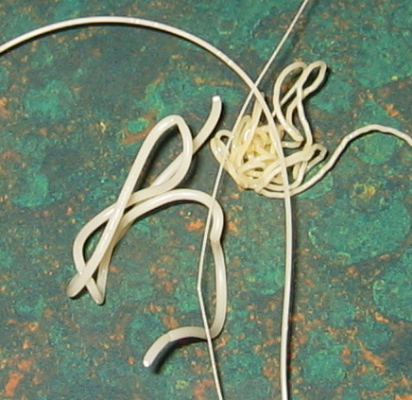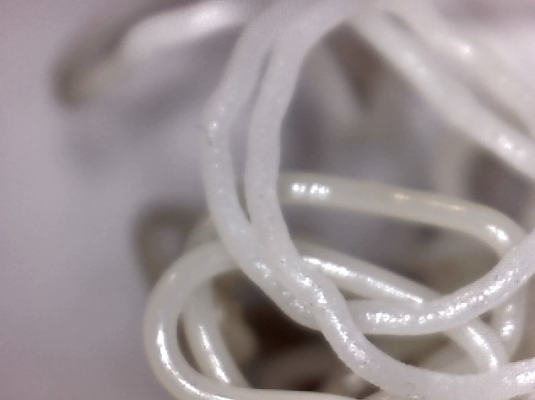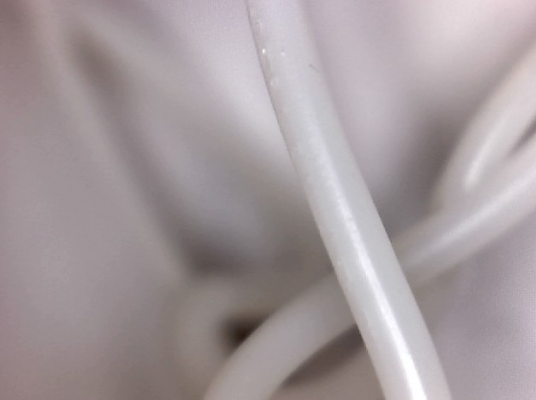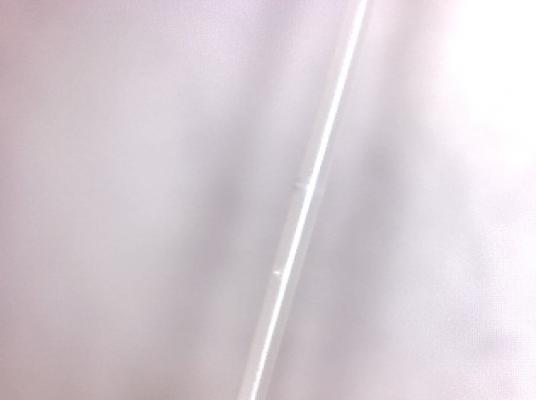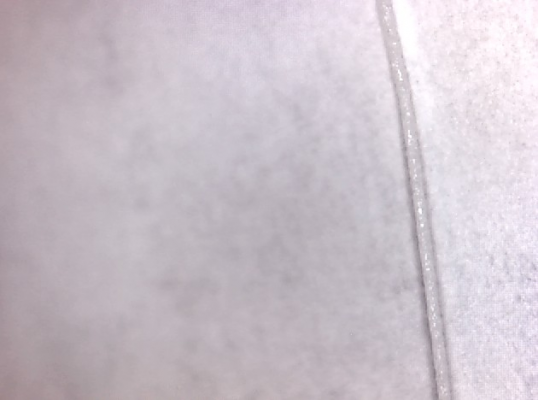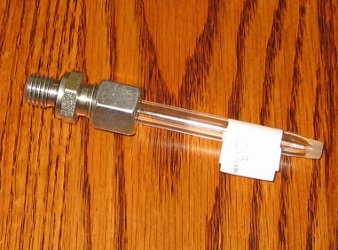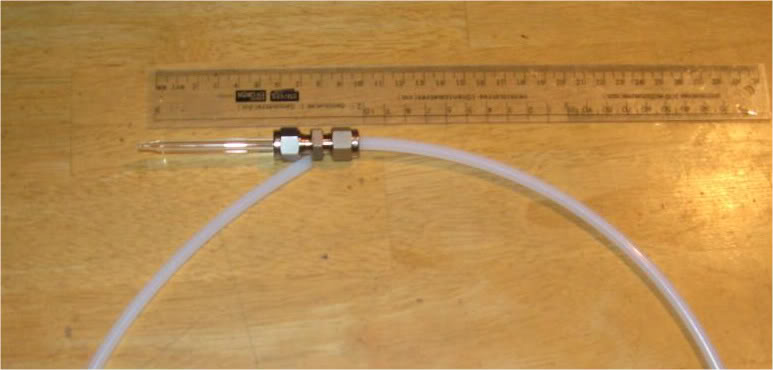Glass nozzles for extruders
Posted by rocket_scientist
|
Re: Glass nozzles for extruders August 24, 2010 07:36PM |
Registered: 13 years ago Posts: 2 |
that looks tedious and difficult to reproduce...i wonder how big of a glass tube you could fit into a micro pipette puller...what are the dimensions of your raw glass?


|
Re: Glass nozzles for extruders August 24, 2010 09:10PM |
Registered: 14 years ago Posts: 380 |
The raw glass is 8mm outside diameter, but you can buy it much smaller than that. And yes, you could use a micro-pipette puller, but that looks like an expensive machine to do what I have been doing with tools on hand. Also, there have been some concerns about the strength and durability of the long drawn out tips. I have already drawn the 8mm down to about a 0.2mm orifice size, but the walls get very thin, too. Great for wrapping nichrome around, and placing the thermocouple much closer to the plastic, but fragile if there should be a Z axis crash. As you notice looking through this thread, I have made of each type. I just don't yet have a machine to test them on.
Mike
Mike
|
Re: Glass nozzles for extruders August 27, 2010 10:14PM |
Registered: 13 years ago Posts: 486 |
Looking at the pictures of the metal-glass interfacing, it occurred to me that you are fully melting the glass rather than softening it and then working it. Have you tried working with the glass without fully melting it but getting past the temperature where it becomes soft? Could you perhaps create the constriction like a balloon animal balloon by softening (but not melting) the glass in the middle of a longer section and then twisting it? This may result in a more repeatable process? Another thought is to jam the softened glass into a hole whose diameter reduces, squeezing the glass into a constriction. If this method works, you could produce a "mold" which included a pin to ensure the opening remained at the desired size.
|
Re: Glass nozzles for extruders August 27, 2010 11:11PM |
Registered: 14 years ago Posts: 380 |
It may be possible with more skill and practice, but actually, I WAS working it in the plastic region. The metal was heavy enough to try and fall out by extending the glass on the low side, and if tipped at all would just fall out. But if I worked it any colder, it would not go around the metal, just get pushed back into the rest of the glass. The bolt worked better because it was almost the right diameter. The brass was bigger, and just didn't work well at all. With the right tools I should be able to blow the glass at the end and make it wide enough to work the brass, but I don't have anything to seal the open end why hot working it. Possible a graphite plug would work. But I have not spent that much money yet on tools for something that has not yet been proven.
|
Re: Glass nozzles for extruders August 30, 2010 01:09PM |
Registered: 14 years ago Posts: 380 |
I built up two more glass nozzles with nichrome wire and thermocouple over the weekend, in part to document the procedures for wiring and mounting the glass nozzles.
Wiki Glass Nozzles
I was also purchased a 40X pocket inspection microscope with 0.05mm per tic reticule to try to actually measure the diameters of each orifice. That way, I was able to select a blunt nosed and tapered point nozzles with close to the same size of the same size. Surprisingly enough, the filaments from the two are quite different. The blunt nosed nozzle still gives a thicker, smoother, and in this case stronger filament. Even though the tapered point had the same size opening, the extruded filament was just under half the diameter. According to the microscope, the tapered nozzle filament was 0.5mm, just like the orifice, but the blunt nosed nozzle's filament was 1.05mm thick. Doing a hand pull test, the thicker filament is much stronger then the thin one. But i need to use spring scales to compare numerically allow for the 4.4 times greater cross sectional area.
I also need to re-wire the tapered nozzle. I went to 34 gauge, and the length became so short that almost all the wire was wound around the taper, and not enough on the straight section to melt the plastic before it gets there. So it took a lot of force, and a high temperature to get it to come out. And even the Kapton tape was smoking!
Mike
Wiki Glass Nozzles
I was also purchased a 40X pocket inspection microscope with 0.05mm per tic reticule to try to actually measure the diameters of each orifice. That way, I was able to select a blunt nosed and tapered point nozzles with close to the same size of the same size. Surprisingly enough, the filaments from the two are quite different. The blunt nosed nozzle still gives a thicker, smoother, and in this case stronger filament. Even though the tapered point had the same size opening, the extruded filament was just under half the diameter. According to the microscope, the tapered nozzle filament was 0.5mm, just like the orifice, but the blunt nosed nozzle's filament was 1.05mm thick. Doing a hand pull test, the thicker filament is much stronger then the thin one. But i need to use spring scales to compare numerically allow for the 4.4 times greater cross sectional area.
I also need to re-wire the tapered nozzle. I went to 34 gauge, and the length became so short that almost all the wire was wound around the taper, and not enough on the straight section to melt the plastic before it gets there. So it took a lot of force, and a high temperature to get it to come out. And even the Kapton tape was smoking!
Mike
|
Re: Glass nozzles for extruders August 30, 2010 03:09PM |
Registered: 13 years ago Posts: 35 |
I like the idea of a glass nozzle for it's simplicity.
You might need to put some glass wool around the nichrome. Glass is such a bad conductor. Most of the energy will be wasted to heat the air around the nozzle. The nozzle will heat faster and temperature would be more consistent with some isolation.
Klaus
You might need to put some glass wool around the nichrome. Glass is such a bad conductor. Most of the energy will be wasted to heat the air around the nozzle. The nozzle will heat faster and temperature would be more consistent with some isolation.
Klaus
|
Re: Glass nozzles for extruders August 30, 2010 04:37PM |
Registered: 14 years ago Posts: 380 |
I have been wrapping extra layers of Kapton tape around the section with wires. But I agree that something more is needed. I intend to experiment with putting a second tube of glass around the heater section after all the wires and thermocouple are installed. That will not only keep more of the heat in, but protect the wiring.
Mike
Mike
|
Re: Glass nozzles for extruders August 30, 2010 08:10PM |
Registered: 13 years ago Posts: 35 |
|
Re: Glass nozzles for extruders August 31, 2010 12:59AM |
Registered: 14 years ago Posts: 387 |
Here is a very plausible replacement for nichrome heating element. This would likely be more suitable for a glass tube nozzle than the Makerbot Mk5-style power resistors that many people are using.
Stackpole Electronics tubular power resistor SWT/EWT series. Handles temperatures up to 350C (silicone coating), 500C (enamel coating).
[www.seielect.com]
25-watt EWT resistor has an inner diameter of about 8 mm. Might be feasible to simply slip one around a glass tube, add thermal paste, secure, and insulate.
Resistors available from digikey, eg. [search.digikey.com]
Stackpole Electronics tubular power resistor SWT/EWT series. Handles temperatures up to 350C (silicone coating), 500C (enamel coating).
[www.seielect.com]
25-watt EWT resistor has an inner diameter of about 8 mm. Might be feasible to simply slip one around a glass tube, add thermal paste, secure, and insulate.
Resistors available from digikey, eg. [search.digikey.com]
|
Re: Glass nozzles for extruders August 31, 2010 01:31AM |
Registered: 14 years ago Posts: 387 |
Similar product, different brand:
[www.heiresistors.com]
[search.digikey.com]
The above products suffer from being rather long (50mm), which means the heater would run nearly the whole length of a typical nozzle. Needless to say, that defeats much of the purpose of using glass nozzles.
These ones below have a lower power rating, but are more compact (16 mm). I believe that the power ratings are not very relevant, because they assume a different application than ours; what matters most is the temperature rating. Like the other vitreous, these should be good to 350C, which is higher than we need.
[www.ohmite.com]
Available from [dilp.netcomponents.com]
The inner diameter might be too small though. I'll keep looking.
Apologies for double-post.
Edited 7 time(s). Last edit at 08/31/2010 02:24AM by jbayless.
[www.heiresistors.com]
[search.digikey.com]
The above products suffer from being rather long (50mm), which means the heater would run nearly the whole length of a typical nozzle. Needless to say, that defeats much of the purpose of using glass nozzles.
These ones below have a lower power rating, but are more compact (16 mm). I believe that the power ratings are not very relevant, because they assume a different application than ours; what matters most is the temperature rating. Like the other vitreous, these should be good to 350C, which is higher than we need.
[www.ohmite.com]
Available from [dilp.netcomponents.com]
The inner diameter might be too small though. I'll keep looking.
Apologies for double-post.
Edited 7 time(s). Last edit at 08/31/2010 02:24AM by jbayless.
|
Re: Glass nozzles for extruders August 31, 2010 06:59PM |
Registered: 14 years ago Posts: 380 |
I was originally thinking I would need a 50W model to handle the temperature derating, then released what you said. We are using them to reach and hold a temperature, not constantly dumping 50W into it regardless of how hot it already is. I think we still need some margin there, because the resistor will always be hotter then the glass, which is always hotter than the plastic, but not by the huge amount they show for operating at 220C (or actually 250 to 260C with all the thermal gaps).
I wonder if we can use a similar technique to make ones that fit the glass nozzles. Get some powdered enamel that is normally fired in a kiln and use it make a heater loop out of nichrome wire, then fire it with the oxy-acetylene torch.
I wonder if we can use a similar technique to make ones that fit the glass nozzles. Get some powdered enamel that is normally fired in a kiln and use it make a heater loop out of nichrome wire, then fire it with the oxy-acetylene torch.
|
Re: Glass nozzles for extruders August 31, 2010 07:25PM |
Registered: 14 years ago Posts: 387 |
Yeah! That's exactly what I'm thinking. I agree that a safety factor is needed -- but on the temperature side, rather than on the power side. Because you're right, the plastic will be cooler than the glass, which will be cooler than the resistor. 
To my knowledge, for a given line of resistors all made from the same material, an increase in power rating refers to an increase in heat sinking capacity rather than an increase in temperature rating. So the resistors get bigger, so that they have a larger surface area, and work as better heat sinks for more amount of power. A 50 watt resistor in open air will reach its maximum safe temperature when you apply 50 watts to it - but that will probably be the same temperature reached by a 5 watt resistor when you run 5 watts through it. I expect that the temperature derating comes mainly from the fact that cooling gets more difficult as ambient temperature increases.
So if we're controlling the temperature, the power rating isn't really important. In fact, a lower power rating might even be better -- as long as it can handle the temperature. It means the heat isn't going to be spread out over a large heater.
For example... When I look at the Ohmite resistors on the Makerbot Mk 5 hot end, I wonder - why are there aluminum heat sinks on those power resistors? They seem counterproductive, because it means that for every watt put into the hot end, a fair amount of that heat is going to be vented into the air, rather than into the melting plastic. And it occurs to me -- it's because the resistors they're using were designed to vent heat, in order to safely handle the amount of power that is put through them. As a result, it means that Makerbot needs to put a lot of power through them to achieve the desired temperature. If the heat sinks weren't there, then it wouldn't increase the temperature of the resistors, it would decrease their power requirements.
So, yes - when looking at power resistors, beware; they're designed to run cool, not to produce heat. So the designers will typically have gone to lengths to spread out the heat production, rather than concentrate it.
What surprises me is that I haven't been able to find purpose-made heating resistors. I suppose ours is a niche application? Strange. Making them ourselves from nichrome is an option... I suppose that was part of the original intention behind the fire cement. But I was hoping for something less labour-intensive, so that if your heater burns out it's easy to swap in a new one.
Edited 1 time(s). Last edit at 08/31/2010 07:27PM by jbayless.

To my knowledge, for a given line of resistors all made from the same material, an increase in power rating refers to an increase in heat sinking capacity rather than an increase in temperature rating. So the resistors get bigger, so that they have a larger surface area, and work as better heat sinks for more amount of power. A 50 watt resistor in open air will reach its maximum safe temperature when you apply 50 watts to it - but that will probably be the same temperature reached by a 5 watt resistor when you run 5 watts through it. I expect that the temperature derating comes mainly from the fact that cooling gets more difficult as ambient temperature increases.
So if we're controlling the temperature, the power rating isn't really important. In fact, a lower power rating might even be better -- as long as it can handle the temperature. It means the heat isn't going to be spread out over a large heater.
For example... When I look at the Ohmite resistors on the Makerbot Mk 5 hot end, I wonder - why are there aluminum heat sinks on those power resistors? They seem counterproductive, because it means that for every watt put into the hot end, a fair amount of that heat is going to be vented into the air, rather than into the melting plastic. And it occurs to me -- it's because the resistors they're using were designed to vent heat, in order to safely handle the amount of power that is put through them. As a result, it means that Makerbot needs to put a lot of power through them to achieve the desired temperature. If the heat sinks weren't there, then it wouldn't increase the temperature of the resistors, it would decrease their power requirements.
So, yes - when looking at power resistors, beware; they're designed to run cool, not to produce heat. So the designers will typically have gone to lengths to spread out the heat production, rather than concentrate it.
What surprises me is that I haven't been able to find purpose-made heating resistors. I suppose ours is a niche application? Strange. Making them ourselves from nichrome is an option... I suppose that was part of the original intention behind the fire cement. But I was hoping for something less labour-intensive, so that if your heater burns out it's easy to swap in a new one.
Edited 1 time(s). Last edit at 08/31/2010 07:27PM by jbayless.
|
Re: Glass nozzles for extruders August 31, 2010 07:56PM |
Admin Registered: 17 years ago Posts: 7,879 |
Yes the Makerbot Mk5 is crazy. All that surface area requires a lot of power and so they need big resistors with more surface area. Then they need a relay to drive it!
I went the opposite way. I found that a smaller resistor enabled a smaller heater block and so needed less power.
[www.hydraraptor.blogspot.com]
I went the opposite way. I found that a smaller resistor enabled a smaller heater block and so needed less power.
[www.hydraraptor.blogspot.com]
|
Re: Glass nozzles for extruders September 02, 2010 11:57AM |
Registered: 14 years ago Posts: 380 |
Here is a video of my second glass nozzle construction test. The fist attempt did not work because it took too long to heat the plastic inside the glass. But the second take on the video, although the lighting is poor, you can see filament coming out a decent rate with reasonable force applied. I also did a third test on the first tapered point nozzle. The results are that it was also hard to push, needed a very high temperature reading on the thermocouple, but the same size opening produced a filament have the diameter, and also bumpy like the brass nozzle.
(second blunt nosed nozzle test video.avi)
Mike
(second blunt nosed nozzle test video.avi)
Mike
|
Re: Glass nozzles for extruders September 03, 2010 02:49PM |
Registered: 15 years ago Posts: 300 |
But it has you DNA input all over it:
1. Thermal mass for easy temp control
2. Short transition zone for the filament feed/melt zone
3. Stainless steel to steepen the zone, minimal heat transfer away from the zone.
4. Resistor heaters for easy assembly
5. Emphasis on reliability
6. Soon to be stepper driven
Thank you for your contribution and systematic experimentation.
1. Thermal mass for easy temp control
2. Short transition zone for the filament feed/melt zone
3. Stainless steel to steepen the zone, minimal heat transfer away from the zone.
4. Resistor heaters for easy assembly
5. Emphasis on reliability
6. Soon to be stepper driven
Thank you for your contribution and systematic experimentation.
|
Re: Glass nozzles for extruders September 03, 2010 09:18PM |
Registered: 14 years ago Posts: 387 |
|
Re: Glass nozzles for extruders September 03, 2010 11:48PM |
Registered: 14 years ago Posts: 380 |
Jacob,
I only have ABS here, so all my tests are with plain ABS. For three of the four tests I have done so far the Katpon tape worked just fine, even at ABS extruder temperatures. They only problem was the tapered nozzle. I think I used to short a piece of nichrome, or to fine a gauge, and it mostly only covers the very tip. With glass being such a power conductor of heat, I am beginning to think that a longer hot zone is needed, to make sure that the plastic is hot all the way through. I want to re-wire the tapered tip and retest it, see if I can avoid releasing some of the not so magic smoke from the Kapton!
Here are the micrographs filaments I got from the brass nozzle in PTFE, first glass nozzle with 1.5mm orifice, second blunt nosed glass with 0.6mm orifice, and first tapered nozzle with 0.5mm orifice:
all four together. The curled up, spaghetti looking one is from the brass, the very thick, somewhat curly one if from the 1.5mm blunt nosed, the medium thick, long and straight is the 0.6mm blunt nosed, and the really thin straight one is from the 0.5mm tapered tip.
It is hard to see even at this magnification, that this filament is rather bumpy, as well as very curly. I do not know why the brass nozzle would make such a bumpy filament, but that is what I found in my first test.
Notice how smooth this one is, especially compared to the brass nozzle.
Here I finally have the correct diameter orifice, but the filament still comes out thicker, more like 1.0mm thickness. Like the first blunt nosed, the filament is very smooth and even. It is also rather strong in hand held pull tests. This is almost the same thickness as the original brass nozzle filament, just smoother and straighter.
Even though the tapered tip had almost identically the same diameter orifice, the filament produced was much thinner, just under half the thickness of the blunt nosed. It is also a bit bumpier, rather like the brass nozzle. This is also weaker, perhaps related to the bumpyness. A jerk test will find the weakest link in the whole length. This would make a very detailed part, but would take a long time to print. As I remember, it also took more force to get even this thin a filament to come out, so cubic mm per second will be quite low.
Mike
Edited 1 time(s). Last edit at 09/04/2010 12:05AM by rocket_scientist.
I only have ABS here, so all my tests are with plain ABS. For three of the four tests I have done so far the Katpon tape worked just fine, even at ABS extruder temperatures. They only problem was the tapered nozzle. I think I used to short a piece of nichrome, or to fine a gauge, and it mostly only covers the very tip. With glass being such a power conductor of heat, I am beginning to think that a longer hot zone is needed, to make sure that the plastic is hot all the way through. I want to re-wire the tapered tip and retest it, see if I can avoid releasing some of the not so magic smoke from the Kapton!
Here are the micrographs filaments I got from the brass nozzle in PTFE, first glass nozzle with 1.5mm orifice, second blunt nosed glass with 0.6mm orifice, and first tapered nozzle with 0.5mm orifice:
all four together. The curled up, spaghetti looking one is from the brass, the very thick, somewhat curly one if from the 1.5mm blunt nosed, the medium thick, long and straight is the 0.6mm blunt nosed, and the really thin straight one is from the 0.5mm tapered tip.
It is hard to see even at this magnification, that this filament is rather bumpy, as well as very curly. I do not know why the brass nozzle would make such a bumpy filament, but that is what I found in my first test.
Notice how smooth this one is, especially compared to the brass nozzle.
Here I finally have the correct diameter orifice, but the filament still comes out thicker, more like 1.0mm thickness. Like the first blunt nosed, the filament is very smooth and even. It is also rather strong in hand held pull tests. This is almost the same thickness as the original brass nozzle filament, just smoother and straighter.
Even though the tapered tip had almost identically the same diameter orifice, the filament produced was much thinner, just under half the thickness of the blunt nosed. It is also a bit bumpier, rather like the brass nozzle. This is also weaker, perhaps related to the bumpyness. A jerk test will find the weakest link in the whole length. This would make a very detailed part, but would take a long time to print. As I remember, it also took more force to get even this thin a filament to come out, so cubic mm per second will be quite low.
Mike
Edited 1 time(s). Last edit at 09/04/2010 12:05AM by rocket_scientist.
|
Re: Glass nozzles for extruders September 03, 2010 11:57PM |
Registered: 14 years ago Posts: 387 |
|
Re: Glass nozzles for extruders September 04, 2010 12:11AM |
Registered: 14 years ago Posts: 380 |
The 6 mm thin walled tubing is too narrow for the 3mm filament to fit. I will try at some point 'blowing' the glass tube wider to accept the filament, but I am not that skilled yet. It should be easy for someone with more practice at actually blowing glass. Next time I order from Hot Glass Color, I will try a 7 mm medium wall to see if it fits better. And to see if thinner is better. Thinner will let the heat flow in radially better, but will not spread the heat between wires or up the tube as well. I am not sure which effect is most important.
Mike
Mike
|
Re: Glass nozzles for extruders September 04, 2010 04:28AM |
Registered: 13 years ago Posts: 35 |
|
Re: Glass nozzles for extruders September 04, 2010 04:46AM |
Registered: 13 years ago Posts: 833 |
How do the differences in roughness of the extruded filament influence printing?
Smoother looks "nicer" and "cleaner", but is it better for printing?
It could create problems sticking to the heating bed (or whatever surface is put on it) or the part itself. Or maybe will it stick better, because there are no bumps creating only dispersed contacts points, while a smooth surface will stick at a bigger surface?
Smoother looks "nicer" and "cleaner", but is it better for printing?
It could create problems sticking to the heating bed (or whatever surface is put on it) or the part itself. Or maybe will it stick better, because there are no bumps creating only dispersed contacts points, while a smooth surface will stick at a bigger surface?
|
Re: Glass nozzles for extruders September 04, 2010 05:24AM |
Admin Registered: 17 years ago Posts: 7,879 |
I think a lot of the roughness and irregularities only occur when extruding into mid air. I think they tend to go away when the plastic is being squashed onto the layer below. For example filament often curls upwards. If I extrude quickly into mid air with my Mendel the filament oscillates and makes a zigzag. There must be some positive feedback. When making objects though these effects go away and the objects are smooth.
[www.hydraraptor.blogspot.com]
[www.hydraraptor.blogspot.com]
|
Re: Glass nozzles for extruders September 04, 2010 01:00PM |
Registered: 14 years ago Posts: 380 |
Peer,
sorry to say that I don't have a working extruder yet, let alone a repstrap or reprap, so I can not answer that question yet. However, at this point, JBayless, Wade, Greg Frost, and mccoyn should have one or more nozzles each to experiment with, and most of them have running machines.
The 4.5mm outside, 3mm inside would have to have 0.75mm thick walls, which is very thin. It might work, or it may be too fragile. Some people are already worried about how thin the glass gets when 2.0mm thick walls are drawn and tapered to a 0.5mm inside diameter, and roughly 0.5mm thick walls at the very tip.
Also, I just received a compression fitting and it fits the 8mm tubing perfectly. From mcmaster-carr, it is ss compression fitting
The only thing I would change is to drill out the glass side a little deeper, so the compressive forces are not so close to the edge of the tube, and possible hidden stresses that could lead to fracture. But only if you have the correct sized drill bit. If you damage the bevel of the compression fitting, it may not hold properly.
Edited 1 time(s). Last edit at 09/05/2010 01:28AM by rocket_scientist.
sorry to say that I don't have a working extruder yet, let alone a repstrap or reprap, so I can not answer that question yet. However, at this point, JBayless, Wade, Greg Frost, and mccoyn should have one or more nozzles each to experiment with, and most of them have running machines.
The 4.5mm outside, 3mm inside would have to have 0.75mm thick walls, which is very thin. It might work, or it may be too fragile. Some people are already worried about how thin the glass gets when 2.0mm thick walls are drawn and tapered to a 0.5mm inside diameter, and roughly 0.5mm thick walls at the very tip.
Also, I just received a compression fitting and it fits the 8mm tubing perfectly. From mcmaster-carr, it is ss compression fitting
The only thing I would change is to drill out the glass side a little deeper, so the compressive forces are not so close to the edge of the tube, and possible hidden stresses that could lead to fracture. But only if you have the correct sized drill bit. If you damage the bevel of the compression fitting, it may not hold properly.
Edited 1 time(s). Last edit at 09/05/2010 01:28AM by rocket_scientist.
|
Re: Glass nozzles for extruders September 04, 2010 01:04PM |
Registered: 14 years ago Posts: 387 |
Fascinating! Although I'm sure Nophead is right that the roughness won't be there when actually printing, I wonder what's causing it. It might just have to do with the way the filament is extruded, or the smoothness of the orifice. But could it be that brass is, so to speak, ABS-philic and glass is ABS-phobic? (As in hydrophilic and hydrophobic; I don't know the actual word for ABS).
If that were the case, then the surface tension in the ABS would cause it to cling together and form a smooth round filament in the case of the glass, but not as much in the case of brass.
If that were the case, then the surface tension in the ABS would cause it to cling together and form a smooth round filament in the case of the glass, but not as much in the case of brass.
|
Re: Glass nozzles for extruders September 04, 2010 01:31PM |
Admin Registered: 17 years ago Posts: 7,879 |
Yes the filament momentarily sticks to the edge of the hole at the brass nozzle exit and then slips, leaving a series of ridges. A bit like pillow lava forming tubes.
[www.hydraraptor.blogspot.com]
[www.hydraraptor.blogspot.com]
|
Re: Glass nozzles for extruders September 05, 2010 03:57AM |
Registered: 14 years ago Posts: 387 |
I'd also like to report that the 6mm glass tube fits great with 6mm compression fittings. I'll soon try it with 1/4". That would allow room for some kapton tape windings to boost the diameter, which also might keep the glass from cracking (although I haven't had any problems with this so far).
I think that, since the pressure in the compression fitting is applied very evenly, the glass is quite unlikely to crack. But I haven't done any destructive tests yet.
I think that, since the pressure in the compression fitting is applied very evenly, the glass is quite unlikely to crack. But I haven't done any destructive tests yet.
|
Re: Glass nozzles for extruders September 08, 2010 01:09AM |
Registered: 13 years ago Posts: 601 |
I also wonder if the conductivity of brass makes for a more fluid boundary between metal and plastic at the orifice, making the surface of the filament more deformable.
edit: I re-read what he wrote
what if you stuffed the glass tube with the thermistor and .5 mm graphite pencil lead, heating it to plasticicity, then just squeezing the plastic glass with a pair of needle nose pliers, enclosing the graphite and thermistor. The nozzle would have a flat cross section, but this would make it stronger, at least in one direction. If you could get a coil of nichrome up there too, that would be even better.
Edited 1 time(s). Last edit at 11/02/2010 04:24PM by Buback.
|
Re: Glass nozzles for extruders September 09, 2010 11:43PM |
Registered: 14 years ago Posts: 387 |
Apologies again for being slow with the progress updates.
I can confirm that the 6mm glass tubes work very well with 6mm compression fittings, as well as 1/4" compression fittings. The connection is extremely rigid. PTFE Bowden cables also appear to work well with compression fittings, allowing neat things like this:
Once I make a heater for the nozzle (likely based on Nophead's design as I haven't been able to find any sufficiently compact tubular resistors) I'll be conducting tests with PLA extrusion.
Edit: Here's my "roadmap" for glass extruders. (Compression fitting depicted is McMaster-Carr 52215K537).
1. Simplest design: PTFE extends only as far as a standard 1/4" tube will go.
This design is the easiest to assemble, but has the potential to form plugs if backflow occurs. This might be problematic with PLA.
2. Upgraded design: PTFE extends throughout the compression fitting.
This reduces the opportunity for plugs to occur. However, either the end of the PTFE tube will need to be trimmed down - likely a difficult procedure - or a short length of 3/16" OD PTFE tubing will need to be cut and added inside.
3. Ideal design: PTFE extends through the fitting and into the glass nozzle.
This design is optimal, because a seamless transition makes plug formation impossible. This will require trimming of the PTFE tube, and perhaps a modified glass tube to accommodate it. It might be easier with an 8 mm glass tube than a 6mm one. Making a narrow PTFE tube like this would be very difficult, however. It might be possible if starting from a solid rod, then lathing down the outside, then center drilling - but I expect it would be tedious and error-prone work.
4. Curious design using 8mm glass tube
Here a thicker-walled glass tube with an inner diameter of 3/16" allows the PTFE tube to extend all or nearly all the way. A PTFE tube that stops short of the end would create a kind of sealed "melt bulb" near the end. It would be worth exploring the properties of an extruder like this. (Depicted with McMaster compression fitting 8239K233).
Edited 4 time(s). Last edit at 09/10/2010 02:13AM by jbayless.
I can confirm that the 6mm glass tubes work very well with 6mm compression fittings, as well as 1/4" compression fittings. The connection is extremely rigid. PTFE Bowden cables also appear to work well with compression fittings, allowing neat things like this:
Once I make a heater for the nozzle (likely based on Nophead's design as I haven't been able to find any sufficiently compact tubular resistors) I'll be conducting tests with PLA extrusion.
Edit: Here's my "roadmap" for glass extruders. (Compression fitting depicted is McMaster-Carr 52215K537).
1. Simplest design: PTFE extends only as far as a standard 1/4" tube will go.
This design is the easiest to assemble, but has the potential to form plugs if backflow occurs. This might be problematic with PLA.
2. Upgraded design: PTFE extends throughout the compression fitting.
This reduces the opportunity for plugs to occur. However, either the end of the PTFE tube will need to be trimmed down - likely a difficult procedure - or a short length of 3/16" OD PTFE tubing will need to be cut and added inside.
3. Ideal design: PTFE extends through the fitting and into the glass nozzle.
This design is optimal, because a seamless transition makes plug formation impossible. This will require trimming of the PTFE tube, and perhaps a modified glass tube to accommodate it. It might be easier with an 8 mm glass tube than a 6mm one. Making a narrow PTFE tube like this would be very difficult, however. It might be possible if starting from a solid rod, then lathing down the outside, then center drilling - but I expect it would be tedious and error-prone work.
4. Curious design using 8mm glass tube
Here a thicker-walled glass tube with an inner diameter of 3/16" allows the PTFE tube to extend all or nearly all the way. A PTFE tube that stops short of the end would create a kind of sealed "melt bulb" near the end. It would be worth exploring the properties of an extruder like this. (Depicted with McMaster compression fitting 8239K233).
Edited 4 time(s). Last edit at 09/10/2010 02:13AM by jbayless.
|
Re: Glass nozzles for extruders September 10, 2010 09:54AM |
Admin Registered: 17 years ago Posts: 7,879 |
Not true unfortunately. If the length of the transition zone is big enough and the coefficient of friction big enough you can get a plug that grips the side of the tube. The more you push, the more pressure it exerts on the tube, that is multiplied by the friction coefficient and so friction matches the extra push. See [hydraraptor.blogspot.com]Quote
a seamless transition makes plug formation impossible.
Depending on how far up the glass tube the heat spreads, you could end up with exactly the same problem.
This is why all my successful designs involve a heatsink as well as an insulator. PTFE tends to get away with a long transition zone because it is so slippery. I don't think glass is in the same league of slipperiness.
[www.hydraraptor.blogspot.com]
|
Re: Glass nozzles for extruders September 10, 2010 10:32AM |
Registered: 14 years ago Posts: 387 |
Sorry, only registered users may post in this forum.
